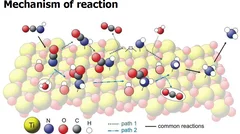News & Highlights
Mystery solved: how fine particulates are formed in the air
Researchers from the Paul Scherrer Institute, the University of Colorado and 29 other research institutions in various countries have investigated the composition of the organic constituents of the fine particulates found in various regions of the world, and have identified the original substances from which they are formed in each case. For the first time ever, this has enabled them to explain the role played by the individual components of emissions in the development of fine particulates.
Vibrational Spectra of Adsorbates from DFT
The hydrolysis of isocyanic acid was studied experimentally and theoretically and a reaction mechanism on different catalysts was established. The decreasing NOx emission limits for diesel vehicles impel the further development of the existing NOx deactivation technologies, particularly the selective catalytic reduction (SCR) of nitrogen oxides with urea. In the urea-SCR process, urea is injected into the hot exhaust gas, where it thermally decomposes into isocyanic acid (HNCO) and ammonia.

